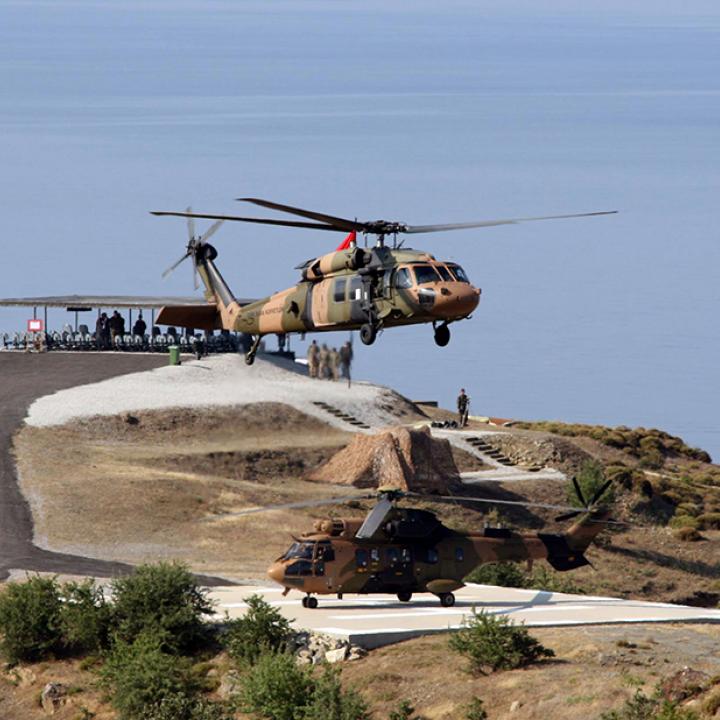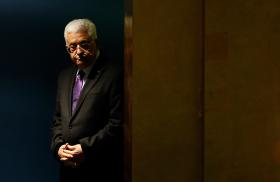
- Policy Analysis
- PolicyWatch 2550
A Turkish-Friendly Zone Inside Syria

Tighter border security would pose an existential threat to IS, not to mention hindering its travel, smuggling, and recruitment efforts.
The attack earlier this month in the Sultanahmet district of Istanbul, Turkey's financial capital, is more likely to harden Ankara's resolve against the Islamic State than to deter it from plans to intensify cooperation with the anti-IS coalition to better seal Turkey's border with northwestern Syria, where IS controls a nearly 60-mile-wide and 20-to-30-mile-deep territory known as the Azaz-Jarabulus (corresponding to Kilis-Cerablus, in Turkey) belt. But the question remains as to how effectively Turkey can seal this long border with IS.
Turkish Policy on Northwestern Syria
Turkey's priorities in northwestern Syria are: (1) boosting support for the rebels it backs to prevent their being squeezed by the recent onslaught of Assad-regime forces and Russian airstrikes; (2) preventing Kurdish Democratic Union Party (PYD) forces, allied with the Kurdistan Workers Party (PKK) -- which Turkey is currently fighting -- from connecting their northwestern Syrian enclave in Afrin, west of Azaz, to other PYD-controlled regions in northern Syria. On this second point, Ankara wants to undercut the formation of a nearly 400-mile-long Kurdish PYD-PKK cordon along its southern border. A third priority for Turkey is now degrading IS in Syria.
Indeed, northwestern Syria -- and the Azaz-Jarabulus belt in particular -- constitutes some of the country's most prized real estate, as well as being a gateway to Aleppo, Syria's largest city before the civil war and a coveted strategic site in the war. As such, this region is contested by PYD-linked People's Defense Units (YPG), Russia-backed Assad-regime forces, al-Qaeda-affiliated Jabhat al-Nusra, IS, and Ankara-backed rebels.
For Ankara, IS's Istanbul attack has only increased this area's value. If IS believed targeting Turkey's foreign tourists and tourism industry would scare Ankara away from increasing border controls -- aimed at stanching both the flow of IS recruits into Syria and smuggled goods out of Syria -- it has a shallow understanding of the Turkish leadership and people. To begin with, the group has minimal support in Turkey, with a pre-attack Pew Research Center poll indicating that only 8 percent of the populace had some sympathy for IS and didn't consider it a terrorist organization. Turkey's Justice and Development Party (AKP) leadership, meanwhile, has won successive elections on a record of solid economic growth and realizes the imperative of defending Turkey's economic nodes from future IS strikes. Accordingly, Turkish president Recep Tayyip Erdogan and prime minister Ahmet Davutoglu will only be hardened in their desire to seal the border with Syria, cutting off recruits and money for IS. The question remains, however, as to whether Turkey can establish control over the IS-controlled Azaz-Jarabulus belt.
Turkish-Syrian Border: An Overview
The border between Turkey and Syria runs for nearly 510 miles and is split by the Euphrates River. From the Euphrates east to Iraq, YPG forces have now wrested control of the entire Syrian side from IS, which held parts of this area during 2014-2015. West of the Euphrates, between the Mediterranean and Azaz -- excluding PYD-controlled Afrin -- anti-Assad opposition forces control the border. These fighters are additionally no friends of IS, and are unlikely to allow IS to benefit from their border position. Separately, a small strip of the border near the Mediterranean and north of Latakia remains under Syrian government control; Syrian and Russian forces are seeking to expand this area. Although Turkey must enhance its border monitoring everywhere, the composition of forces on the Syrian side will allow it to devote most resources further east, namely in Azaz-Jarabulus.
This border region -- the rolling hills and plains between Azaz (Kilis, on the Turkish side) and Jarabulus west of the Euphrates -- deserves attention. Effectively sealing the Azaz-Jarabulus belt from the flow of IS money and personnel will require tools such as unmanned aerial vehicles (UAVs), aerostats, movement sensors, and a coordination-and-control facility, in addition to an influx of security personnel.
A Turkish-Friendly Zone?
The most effective way to monitor the Azaz-Jarabulus border area would be to ensure that the Syrian side is filled by forces friendly to Turkey, or at least opposed to IS. One possible such group would be the Syrian Turkmens, who are ethnically related to Turks and are being trained by Turkey as a fighting force in northwestern Syria.
The zone, for its part, could serve multiple purposes, such as providing enhanced personal security for those fleeing barbaric Assad or IS rule, a staging area for anti-Assad forces, and an area for reducing the refugee flow into Turkey and then on to Europe. The idea of a Turkish-friendly zone would receive support in European countries already feeling overstressed by the Syrian refugee arrivals. Such an area would also interdict the movement of resources to IS, hence weakening the group, as well as allow Ankara to impede the movement of IS operatives into Turkey to target its economic resources, such as tourism. The area's creation would demonstrate to the Turkish people and allied countries that Ankara is serious about defeating IS even as it continues seeking stronger action against the Assad regime.
Needless to say, a secure zone between Azaz and Jarabulus would need protection from the Turkish side. Questions here center on whether Ankara could protect its residents from either IS or Syrian-regime attack, and defend its clients sealing the border on the Syrian side. Indeed, if the Turkish government has the will, it will have the means. And while deploying forces to southeastern Turkey to fight the PKK has made fewer soldiers available to secure the border west of the Euphrates, many of Turkey's army personnel are conscripts with a short-term obligation who, given their lack of training, would best be used to support Ministry of Interior forces in securing the border rather than in highly dangerous anti-PKK operations.
In addition to a large number of conscripts, the Turkish armed forces has modern artillery with an effective range of twenty to twenty-five miles, UAVs, and other means to protect its clients administering a prospective safe zone. Many of these assets are already located near the proposed zone, while others could and should be shifted from the Aegean region, where Turkey has little need for them; on the former count, the fifth armored brigade is based in Gaziantep, about twenty miles north of the border. Further, if the Turkish-PKK peace process could be revived, assets could also be shifted from southeastern Turkey to protect this secure zone. As part of a deal with Washington to set up this Turkish-friendly zone, Ankara might acquiesce to PYD control of noncontiguous territorial pockets west of the Euphrates and in areas beyond the twenty-five-mile reach of Turkish artillery. This limitation explains, for instance, why Turkey acceded to the December 26 crossing by the PYD-aligned Syrian Democratic Forces to the west of the Euphrates around Tishrin Dam.
Conclusions for Washington and Ankara
Along with other lessons, the Sultanahmet bombing reveals the Islamic State's recognition of the existential threat the effective sealing of the Turkish border would mean for the group. Already, enhanced Turkish airport security has hindered IS recruitment and travel, to the extent that the group has called for action elsewhere -- e.g., in Paris, California, and Jakarta -- rather than face interdiction or arrest by traveling to Syria through Turkey. The Istanbul attack thus reflected an attempt to dissuade Turkey from proceeding with Washington in efforts to seal the border and capture the Azaz-Jarablus belt from IS. More likely, though, IS has stiffened the Turkish leadership's resolve to eliminate the group as a threat to the country's economic progress and security.
Ed Stafford is a foreign service officer currently teaching at the Inter-American Defense College. Mr. Stafford’s views are his own and do not necessarily reflect those of the Inter-American Defense College, the Department of State, or the U.S. government.
Soner Cagaptay is the Beyer Family Fellow and director of the Turkish Research Program at The Washington Institute.



